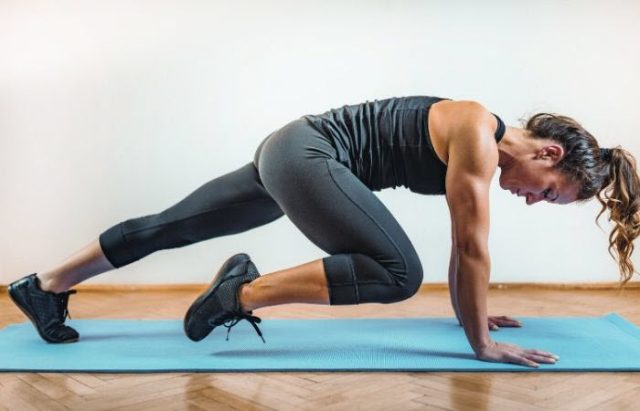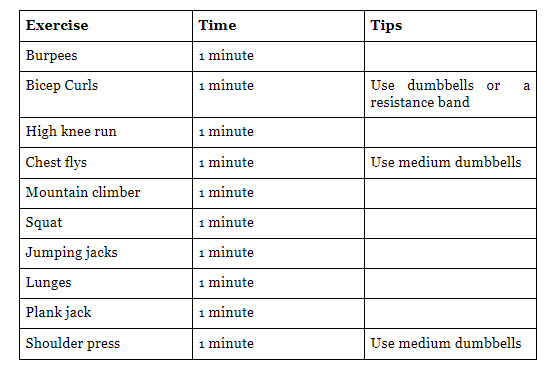Super Tips to Create Your Home HIIT Workout
By Contributor
January 10, 2024 • Fact checked by Dumb Little Man

Not everyone has the time and resources to go to a gym or hire a personal trainer. Gym memberships are expensive and it’s tough to find time to travel to a gym especially when you live a busy lifestyle. Also, on many occasions, you may find yourself wasting time waiting for equipment to free up or talking to fellow gym members.
High-intensity interval training (HIIT), on the other hand, allows you to workout from anywhere without the need for special equipment. The workout gets your heart and blood pumping in no time. It’s perfect for home workouts because they fit your schedule and burn calories quickly. Also, HIIT is more effective than mindlessly jogging on a treadmill at the gym.
Here are a few quick tips that’ll help you build a robust HIIT workout regimen.
Start with Warming Up

As the name suggests, warm-up exercises are supposed to get your muscles fired up and your body feeling slightly warm. Make sure you start with dynamic stretches and high jumps to improve athletic performance, mobilize joints, and avoid injuries.
Follow this warm-up routine before each HIIT workout session.
- Round 1
Hip Rotation – 10 per side
Thoracic Reach Throughs – 6 – each with 5-second holds
Cat and Camel Stretch – 5-second holds – 3 per side - Round 2
30 High Knees per leg
10 Squats
20 Glute Bridge
Choose Your Fitness Adventure
Depending on whether you are a beginner, intermediate, or pro, determine the amount of time are you willing to commit to a workout. A proper HIIT workout can be completed anywhere between 10 to 30 minutes.
Based on your current fitness level, you can choose from cardio movements like burpees, high-knee run, mountain climbers, and jumping jacks. Next, add some strength exercises like bicep curls, chest flys, or push-ups.
So, here’s how a 10-minute workout will look.

If you are an intermediate or pro, expand this workout regimen to 20-30 minutes.
Besides, make sure to incorporate resistance training with compound movements like push-ups, pull-ups, and kettlebell swings. This will recruit most of your muscles and burn more calories. Movements like squats and burpees are especially fruitful as they contain larger muscle groups.
Find the Perfect Work to Rest Ratio
Overtraining (just like undertraining) your body can hinder your progress. Hence, it is important to find the right balance for your skill level. Know your work-to-rest ratio based on your current skill level to get the most out of your HIIT sessions.
- Beginners: They should feel challenged by a 1:2 ratio. In other words, 30 seconds exercise followed by 1 minute of rest.
- Low-Intermediate Trainers: Fitness enthusiasts at this level should strive for a 1:1 ratio.
- High-Intermediate Trainers: They should strive for 2:1
- Expert-Level Athletes: They can go as high as 5:1 or 50 seconds of training followed by 10 seconds of rest.
Remember to Fuel Up

HIIT isn’t a run-of-the-mill cardio workout that can be done on an empty stomach. Pre-workout nutrition is key to optimizing your workout performance. Include fast-digesting proteins and carbohydrates to fuel your body with energy and amino acids for rebuilding muscle.
Make sure you consume about 20 grams of carbohydrates in your meal to power you through the workout. You could also take a pre-workout supplement to increase power for workouts and perform your best during quality and force exercises. Finally, keep a water bottle handy to stay adequately hydrated.
Listen to Your Body
To improve your performance and get stronger, you should challenge yourself with a little more physical work than you did before. Yet, it’s important to remember where to draw the line.
Don’t push your body too much! If you have a HIIT workout planned and you feel fatigued, take a break and allow your muscles to recover. Alternatively, you could follow an easier low-impact cardio workout that allows you to flex your muscles but doesn’t overwork them.
Know when to avoid HIIT. On days you feel sore from your previous workout or have pulled a muscle, it’s wise to avoid HIIT.
If you are a beginner, start with few short-duration high-intensity intervals followed by one HIIT session per week. As your body adapts to the stress of HIIT, you can add more and longer intervals.
Moreover, remember that overtraining with HIIT can cause you to lose muscle mass (along with loss of fat). So, if you’re aiming at building your muscle mass, have weight training as your primary workout with HIIT as a supplement.
Ever since it was introduced, HIIT has been exploding in popularity in the fitness world – and for a good reason! Several studies have shown that HIIT can optimize muscle gain and offer cardiovascular benefits while minimizing the catabolic effects of high-intensity exercises. Use the tips shared above to design a workout regimen that best suits your needs.
Want to know more about HIIT? Check out this infographic by Rubcorp that offers interesting facts and information on the history of HIIT.
Infographic source: Rubcorp


